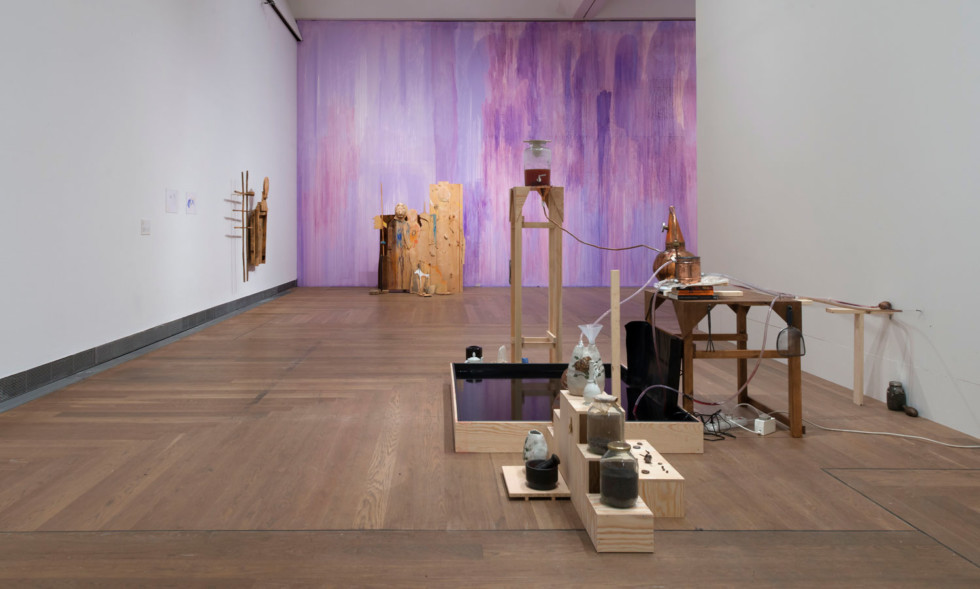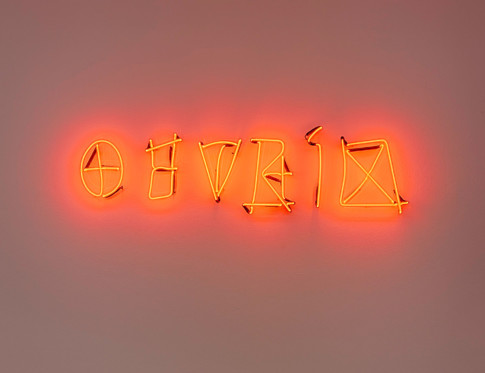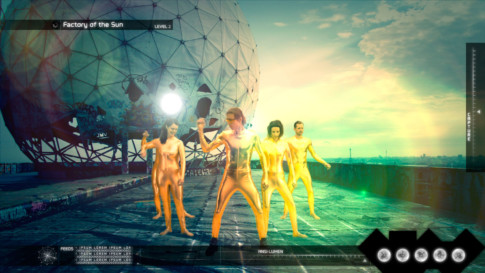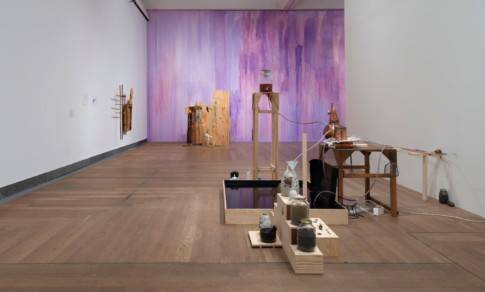
Installation view Manipulate the World – Connecting Öyvind Fahlström, Moderna Museet 2017. Candice Lin, System for a Stain, 2016 © Candice Lin. Rósa El-Hassan, How to Proceed? Human Collective 2017 © Rósa El-Hassan. Thu Van Tran, Penetrable, 2017 © Thu Van Tran. Photo: Åsa Lundén/Moderna Museet
Works and Artists in Manipulate the World
Lawrence Abu Hamdan
Rossella Biscotti
Juan Castillo
Asli Çavusoglu
Kajsa Dahlberg
Detanico Lain
Economic Space Agency
Róza El-Hassan
Harun Farocki
Öyvind Fahlström
Goldin+Senneby
Núria Güell
Candice Lin
Jill Magid
Ibrahim Mahama
Nicholas Mangan
Sirous Namazi
Rivane Neuenschwander
Otobong Nkanga
Sondra Perry
Pratchaya Phinthong
Katarina Pirak Sikku
Natascha Sadr Haghighian
Jonas Staal
Hito Steyerl
Hanan Hilwé i samarbete med Walid Raad
Thu Van Tran
Alexander Vaindorf
Wermke/Leinkauf
Films about the artworks with participating artists
The artists Pratchaya Phinthong, Katarina Pirak Sikku, Ibrahim Mahama and Thu Van Tran talk about their works in the exhibition.
Lawrence Abu Hamdan
Born 1985, Jordan/Germany
Earshot, 2016
Two young Palestinian civilians, Nadeem Nawara and Mohammad Mahmoud Odeh Abu Daher, were shot to death by Israeli soldiers on the West Bank in 2014. Lawrence Abu Hamdan has analysed the sound from the gunfire. His investigation proves that live rounds had been fired, not rubber bullets as Israel claimed. The news was broadcast in international media, and the information was also discussed in the US Congress, where it was argued that Israel had violated its arms agreement with the USA. Abu Hamdan’s installation reflects on the political dimensions of sound and silence.
More about Lawrence Abu Hamdan: http://lawrenceabuhamdan.com/
Rossella Biscotti
Born 1978, Italy/The Netherlands
The Heads in Question, 2015
Prior to the World Fair in Rome in 1942, the Italian dictator Benito Mussolini drew up plans for the fascist district EUR in south Rome. The fair was cancelled due to the Second World War, but EUR was completed in the 1960s. In 2009, Rossella Biscotti discovered that five bronze heads portraying Mussolini and King Vittorio Emanuele III, commissioned for the World Fair but never exhibited, had been preserved in a cellar in the district. She made moulds of these heads, thereby inverting the shape of the sculptures and the commissioning of these monuments.
More about Rossella Biscotti: https://www.mor-charpentier.com/artist/rossella-biscotti/
Juan Castillo
Born 1952, Chile/Sweden
Another Day/En annan dag, 2014–17
From 1979 to 1983, Juan Castillo belonged to the Chilean artist collective C.A.D.A., which he had co-founded. This conceptual art group highlighted and challenged the Pinochet dictatorship in Chile, often in the form of performances and social interventions. In Another Day, he writes the phrase “Te devuelvo tu imagen” (I give you back your image) on a textile screen set against the Chilean landscape, before igniting it.
More about Juan Castillo:
http://juancastillo.net/bio.php
http://galeriaisabelaninat.cl/artista/juan-castillo/
Asli Çavusoglu
Born 1982, Turkey
A Few Hours After the Revolution, 2010
The word devrim – revolution – is often written in the streets by left wing activists in Turkey. But nationalists routinely add a few lines and scribbles to the letters to make the graffiti abstract and illegible. One action in turn triggers a counteraction. In this work, the artist has reproduced the modified graffiti as a neon sign.
More about Aslı Çavuşoğlu: http://aslicavusoglu.info/
Kajsa Dahlberg
Born 1973, Sweden/Norway
Female Fist, 2005–08
An activist in Copenhagen’s feminist queer community talks about the production of a lesbian porno movie. Kajsa Dahlberg conducts the interview without removing the lens cover from the camera – a reference to the collectives that hide their faces and identities to gain political visibility. What interests Dahlberg is that the fight against repressive structures has compelled the group to identify itself in negative terms, for instance: We are not anarchists. By formulating what they are not, and what they do not belong to, they are free to produce counter-images to the normative narratives that are widely distributed in the media.
More about Kajsa Dahlberg:
http://kajsadahlberg.com/
http://www.kkh.se/en/kajsa-dahlberg/
http://www.parra-romero.com/artistas/kajsa.html
Detanico Lain
Timezonetype, 2017
Detanico Lain have been commissioned to create an intervention in the communication of the exhibition. Their work is a typeface based on the American astronomer Nathaniel Bowditch’s (1776–1838) system where Earth’s 24 time zones are each represented by a letter of the Roman alphabet; the system is used mainly for navigation. In Timezonetype, each letter corresponds to the shape of its time zone. The exhibition title, Manipulate the World written in Swedish with Timezonetype on the large wall in the entrance area thus resembles a manipulated map. The typeface is also used for posters and digital communication of the exhibition.
More about Detanico Lain: http://detanicolain.com/
Economic Space Agency
Economic Space Conference, 2018
Economic Space Agency is a startup company in San Francisco with the aim of democratising the financial sector. Their innovations in cryptocurrency – i.e. digital currencies such as bitcoin – have been described as an alternative way of occupying Wall Street. Their network extends from post-Marxist philosophers and human rights activists, to internet innovators and financial anarchists. Economic Space Agency has been invited to hold a one-day conference to conclude the exhibition.
Róza El-Hassan
Born 1966, Syria/Hungary
How to Proceed? Human Collective, 2017
Sphere Garden, 2017
Freedom Statue, 2014
Breeze, 2014
“How to proceed in these times of humanitarian disasters, racism, organ trafficking, climate change…” is a fundamental question for Róza El-Hassan. She seeks to address such difficult issues in sculptures and other works. In her own words, “Step by step I added colour and optimism and love (I should not speak so pathetically… I know, but it is honest). I tried to imagine positive change, starting from an outcry about crimes against humanity.”
More about Róza El-Hassan:
http://www.roza-el-hassan.hu/
www.syrianvoicesmediationandart.wordpress.com
Harun Farocki
1944–2014, Czech Republic/Germany
Watson is down (Serious Games I), 2010
This work is part of a series of video installations exploring the links between technology, politics and violence. Digitally simulated war scenarios that were developed into popular video games were initially produced for military training purposes. These war games were used as tools for education and recruitment and are now also used in therapy. Harun Farocki filmed a military drill in California, where four US Marines simulate an assignment in Afghanistan.
More about Harun Farocki: http://www.harunfarocki.de/home.html
Öyvind Fahlström
1928–1976
Dr. Schweitzer’s Last Mission, 1964–66
Tempera on 8 metal boxes, 10 cut-out boards, 50 magnetized metal and vinyl cut-outs
Memory list (For Dr.Schweitzer’s Last Mission), 1964
Lithograph on paper
Notes for Dr.Schweitzer‘s Last Mission B 1–2, 1966
Tempera and India ink on paper
World Trade Monopoly (A, Small), 1970
Variable painting. Acrylic and India ink on magnets and vinyl
World Trade Monopoly (B, Large), 1970
Variable painting. Acrylic and India ink on magnets and vinyl
Mao-Hope March, 1966
Black and white, sound, 16 mm film, 4:30 min
World Bank, 1971
Acrylic and India ink on vinyl, gold leaf on wood, plexiglass and velvet
This exhibition marks the culmination of Moderna Museet’s project on the artist Öyvind Fahlström, consisting of exhibitions, publications, research and events in 2014–2018. The title, Manipulate the World, is taken from a text Fahlström wrote about his variable paintings in Art and Literature No 3, 1964
More about Öyvind Fahlström: http://www.fahlstrom.com/
Goldin+Senneby
Since 2004, Sweden
Zero Magic, 2016–17
In Zero Magic, 10% of the proceeds of each entrance ticket is invested in a so-called short selling attack on the financial market. By actively circulating information aimed at lowering the value of a publicly listed company such an investment can potentially generate a profit. But the money can just as easily be lost, if the speculation proves wrong. The entrance tickets themselves contain information about the investment and functions as a receipt of the visitor’s participation in the short selling attack. The outcome of the investment will be presented at the close of the exhibition, and any profits will be donated to the Museum as a conditional gift.
More about Goldin+Senneby: http://www.goldinsenneby.com/gs/
Núria Güell
Born 1981, Spain
Intervención #1/Intervention #1, 2012
After a Spanish bank evicted residents who had defaulted on their mortgages, the bank bought their houses at a compulsory auction at 50% of the market price. In Intervention # 1, Güell started a cooperative, where one of the evicted people, a mason, was hired to remove the front doors of the buildings in question. In Spain, squatting in a domicile without a front door is not a punishable offence. Legal constructions similar to those used by the banks when acquiring the houses protected the hired mason from prosecution.
More about Núria Güell:
http://www.nuriaguell.net/
http://www.adngaleria.com/web/pag/fitxa_img.asp?i=543&o=4&la=en
Candice Lin
Born 1979, USA
System for a Stain, 2016
In this work a liquid is distilled, coloured and pumped through a tube around the exhibition onto a fake marble floor, where it forms a blood-like stain. Distiller and stain are separated so that they cannot be seen at the same time. The liquid contains sugar, tea and cochineal, typical colonial goods. The machine uses a statuette of the Scottish botanist Robert Fortune (1812–1880) as a strainer. Fortune was enlisted by the British East India Company to perform industrial espionage on the valuable Chinese tea plant.
More about Candice Lin:
http://ghebaly.com/work/candicelin/
http://www.quadradoazul.pt/en/qa/artist/candice/
https://www.gasworks.org.uk/exhibitions/candice-lin-a-body-reduced-to-brilliant-colour-2016-09-22/
https://www.gasworks.org.uk/2016/09/22/Candice_Lin_Exhibition_Handout.pdf
Jill Magid
Born 1973, USA
Failed States, 2011–12
When Houston resident Fausto Cardenas fired six shots from a handgun in the air from the steps of the Texas State Capitol in Austin, 2010, Jill Magid was passing through the building while doing research on snipers and surveillance systems. Having witnessed the event, she was interviewed by reporters. Magid then followed the prosecution of Fausto, who was charged with perpetrating a terrorist act. It ended with a settlement, where Fausto took a plea bargain and signed a confidentiality agreement. The event remained shrouded in mystery, and is the starting point for a work where the artist’s bullet-proof car and references to Goethe’s Faust are intertwined with personal and public statements.
More about Jill Magid:
http://www.jillmagid.com/
http://www.labor.org.mx/en/artists/jill-magid/
http://untilthen.fr/artistes/jill-magid/oeuvres/
Ibrahim Mahama
Born 1987, Ghana
Location, 2016–17
This work consists of jute sacks that are normally used to transport commodities from Ghana. Ibrahim Mahama gets these sacks by offering the traders new ones. Like a giant collage on the walls of the Museum, the sacks are silent witnesses of trade routes and working conditions. Location could be said to process the value system of the post-colonial economy.
More about Ibrahim Mahama:
https://www.apollo-magazine.com/ibrahim-mahama-apollo-40-under-40-global-the-artists/
http://whitecube.com/artists/ibrahim_mahama/
Nicholas Mangan
Born 1979, Australia
Limits to Growth, 2016
This installation consists of two parts: A computerised “mine” that generates the digital currency bitcoin, and a printer for photographic images, located in a separate room. When the mine has generated sufficient financial value to pay for a print of an image, the printer produces a photo on a yap stone. These large limestone discs from the island of Yap in the Pacific served as a medium of exchange more than 1000 years ago. The work shares its name with a famous report from 1972 commissioned by the think tank Club of Rome, which warned against the effects of unbridled economic growth.
More about Nicholas Mangan: http://www.nicholasmangan.com/
Sirous Namazi
Born 1970, Iran/Sweden
Chandelier/Sink/Refrigerator/Stairs, 2014
From the series Twelve Thirty
Sirous Namazi’s home in Iran was looted and destroyed when he was a child, as a result of the regime’s persecution of the minority religion Bahai. His family fled to Sweden, where they have lived since then. In this work, Namazi reflects on the event, the nature and purpose of memory, and home as a place. The sculptures are reconstructions of objects that were destroyed, and are based on his family’s memories and a few salvaged photos.
More about Sirous Namazi:
http://www.sirousnamazi.com/
http://www.nordenhake.com/php/artist.php?RefID=43
Rivane Neuenschwander
Born 1967, Brazil
Untitled (Vernacular Furniture) Sweden, 2012
The furniture in the museum’s coffee bar and in the exhibition reading areas were made by Rivane Neuenschwander in collaboration with Nyckelviksskolan and Birger Lipinski & Laercio Redondo. The project was launched after Neuenschwander saw the collection of vernacular furniture at the Skansen outdoor museum in Stockholm. The furniture was then modified according to the Nyckelviksskolan students’ ideas about place, globalisation, contemporary society and heritage. Their reinterpretation of Swedish folklore can be related to the cultural movement in Brazil called Antropofagia (cannibalism), where the manipulation of other cultures was presented as a strength in relation to post-colonial European dominance.
Otobong Nkanga
Born 1974, Nigeria/Belgium
Carved to Flow, 2017
O8 Black Stone, a cold processed soap created by Otobong Nkanga is made of butter and oils from around the Mediterranean, Middle East, North and West Africa. It contains charcoal, which suffocates the odors of all other ingredients and renders it black. The soap was produced in Athens and Kalamata (Greece), vended in Kassel (Germany), during documenta 14. In Stockholm, it has taken the form of 5000 soaps, shipped here from Kalamata, then stored on the lower floor of the exhibition and sold at a purpose-built sales desk. Over time, the material part of the work will disperse and disappear.
More about Otobong Nkanga:
http://www.otobongnkanga.com/
http://www.carvedtoflow.com/
Sondra Perry
Born 1986, USA
Wet and Wavy Looks – Typhon coming on for a Three Monitor Workstation, 2016
Graft and Ash for a Three Monitor Workstation, 2016
Sondra Perry’s video Wet and Wavy Looks […] combines a close reading of William Turner’s painting Slavers Throwing Overboard the Dead and Dying, Typhoon Coming On (1840), with a slow-motion sampling of Missy Elliot’s The Rain (Supa Dupa Fly) from 1997, as seen from a rowing machine. In Graft and Ash […] the three video screens are attached to an exercise bike. The artist’s avatar refutes the so-called just world hypothesis, the notion of a universal or cosmic “justice”. The soundtrack consists of meditation music from YouTube.
More about Sondra Perry: http://sondraperry.com/
Pratchaya Phinthong
Born 1974, Thailand
An Average Thai Berry Picker’s Income, 2010
Give More Than You Take, 2010
549 kg (poster), 2017
Through migrant workers from Thailand, Pratchaya Phinthong learned about the working conditions for berry pickers in the north of Sweden. The following year, Phinthong went there himself to work, and picked 549 kilos of berries in two months, earning SEK 2513. The employer paid the workers in cash from an old safe. Phinthong’s fellow pickers who left a month later were not payed at all; the employer departed ahead of the workers leaving the safe open and emptied. This has inspired a newly-made poster, printed in an edition that corresponds to the weight of the berries. Also on display is a hunting tower that Phinthong and his compatriots chopped down.
More about Pratchaya Phinthong:
http://www.givemorethanyoutake.net/
http://messysky-blog.tumblr.com
http://www.gbagency.fr/en/49/Pratchaya-Phinthong/
Katarina Pirak Sikku
Born 1965, Sápmi/Sweden
Gállok-Kallak, 2013
When exploratory blasting was carried out for mineral prospecting in Gállok/ Kallak outside Jokkmokk in northern Sweden 2013, this provoked protests in the region. Katarina Pirak Sikku took part in the protests. During a police intervention, she spread large, white geotextiles in front of the protesters. When the police, demonstrators, the prosecutor and representatives of the mining company walked or drove across this surface, their tracks were documented. The textile thus became contemporary frottage, bearing the marks of the ground underneath and the events above it: the “earth’s testimony”.
Natascha Sadr Haghighian
Born 1968, Germany
unternehmen:bermuda, 2000/12
In 2000, Natascha Sadr Haghighian was nominated for an art award given by a federation of German industries. She relocated the jury’s studio visit to a bus stop in Berlin Mitte, situated in a triangle of three institutions of art and science. She gave a lecture and supplied instructions for a series of actions. Two ‘undercover agents’ documented the situation, framing the jury members as protagonists of a joint performance. The documents are presented together with a film which draws connections between the Bermuda triangle, Shakespeare’s The Tempest, 16th century court alchemist John Dee, and Michelangelo Antonioni’s film Blow Up (1966).
More about Natascha Sadr Haghighian: www.possest.de
Jonas Staal
Born 1981, The Netherlands
The Geert Wilders Works, 2005–08
Beginning in 2005, Jonas Staal has made a series of interventions in urban spaces, focusing on the ultra nationalist party leader Geert Wilders. Photos of Wilders together with flowers, teddy bears and burning candles were presented in public places without comment, provoking violent controversies. Wilders sued the artist for threats to his life. Staal was acquitted by a court on the grounds that it could not be proven whether the interventions were threats or tributes. Staal regards all the events following his action as part of an ongoing performative artwork. The installation includes a police photograph and a drawing from the courtroom.
More about Jonas Staal: http://www.jonasstaal.nl/
Hito Steyerl
Born 1966, Germany
Factory of the Sun, 2015
The story of young workers in Factory of the Sun – whose movements are transformed into artificial sunlight – is told by Yulia, a computer game programmer who migrated from the Soviet Union due to the persecution of her family. Factory of the Sun “plays you”, she says, and then fact and fiction are mixed with her own biography. Yulia’s brother has become famous as a choreographer and dancer to pop tunes on YouTube, and anime characters have been created in East Asia based on his moves. These characters have the power to bend light, in a collective resistance against authoritarian regimes.
Hanan Hilwé med Walid Raad
Born 1967, Lebanon/USA
Yet More Letters to the Reader, 2017
The wooden crates in this work were painted by Hanan Hilwé. As Chief Curator for the Abu Dhabi Museum, she purchased the Erich Maria Remarque and Paulette Goddard collection for Sheikh Zayed at an auction in 1979. The Sheikh hated the works and Hilwé herself doubted their “authenticity”. She tried to give the works back but kept failing – mysteriously the artworks kept returning to the storage in Abu Dhabi. Upon receiving advice that the works might be undead she started to paint “reverse magnets” or “mirror images” to keep them away. It worked. These crates are copies of the original crates which remain in Abu Dhabi for obvious reasons.
More about Walid Raad:
http://jalaltoufic.com/
http://theatlasgroup.org/
https://www.paulacoopergallery.com/artists/walid-raad/selected-works
Thu Van Tran
Born 1979, Vietnam/France
Overly Forced Gestures (De Récolte à Révolte), 2017
Penetrable, 2017
Red Rubber, 2017
Thu Van Tran’s work consists of three parts, each relating to rubber as a historically important raw material in the colonial exploitation of Vietnam. The large wall painting, made of rubber and a chemical pigment, stains the white wall of the exhibition space and seems to spread infinitely. One of the films projected on the painting shows workers on a plantation in Vietnam belonging to a major tyre manufacturer, the other shows a series of petrified hand gestures relating to dominance. The Hevea tree from which rubber is extruded, is monumentalised in casted sculptures.
More about Thu Van Tran: https://thuvantran.fr
Alexander Vaindorf
Born 1965, Ukraine/Sweden
In the Shadow of the Monument, 2009
In 1931, Carl Milles (1875–1955) made The Aviator Monument in honour of aviation pioneers who had fallen. The work is crowned by an eagle with a striking resemblance to the Nazi Party emblem that came into use in 1935. Milles was an avid admirer of Hitler and Mussolini. The monument has become a meeting place for several generations of Nazis. In his work, Vaindorf lets the eagle speak, proposing two ideas: one is that the sculpture be moved from Karlaplan to Millesgården – the sculptor’s former home and studio – or that a copy of the monument be erected, which on a sunny day would cast a shadow on the original.
Wermke/Leinkauf
Germany
Symbolic Threats, 2015
Wermke/Leinkauf staged a secret action on the Brooklyn Bridge in New York, replacing the two American flags on the towers with white flags. The work records the media and political reactions to this unexpected event.
More about Wermke/Leinkauf: http://www.wermke-leinkauf.com



